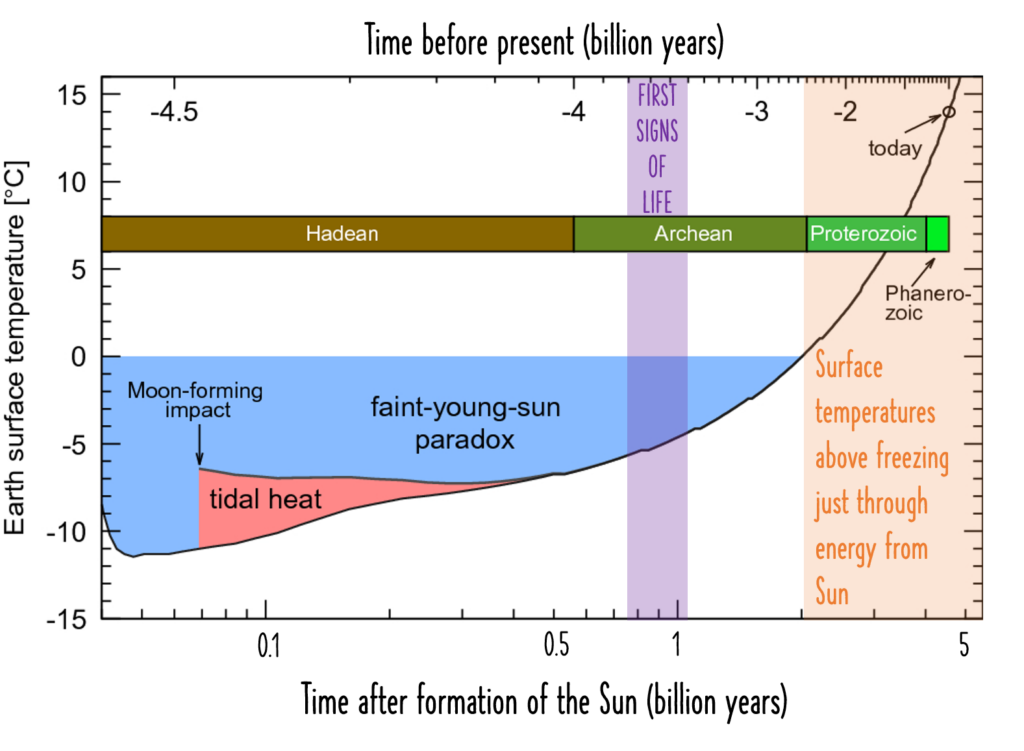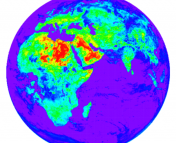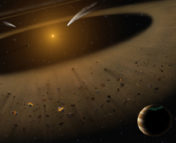Authors: René Heller, Jan-Peter Duda, Max Winkler, Joachim Reitner & Laurent Gizon
First author university: Max Planck Institute for Solar System Research, Germany
Status: PalZ, open access
Earth. The perfect example of a planet in its habitable zone: abundant liquid water oceans, a 3.8 billion year record of life, and a surface teeming with complex, multicellular organisms. Surely if any other civilizations had ever taken a glance at our solar system in the search for habitable planets, they would have recognized ours as a great candidate, right?
Well, maybe. As long as they weren’t pointing their telescopes at us more than 3.5 billion years ago…
A half-century of head-scratching
4.4 billion years ago, our Sun only radiated about 70% of the energy that it does today. A 30% change might not seem like too much, but climate models since the 1970s have shown that the effect on Earth’s temperature would be dramatic. It could be the difference between an Earth similar to the one we live on today, and an Earth with an average surface temperature below -10°C entombed in a global layer of ice!
That is, someone looking at the early Earth based on the same habitable zone astronomers apply to exoplanets today would have seen a planet about as promising as our own frozen sibling, Mars.
The Earth’s most ancient rocks have something to say about this hypothesis, though. Chemical signals in the most ancient fragments of Earth’s crust, and 3.5 billion year old pillow lavas that could only have formed underwater, show that Earth definitely wasn’t in a frigid snowball state at this very early time. This is one of the greatest unsolved mysteries in Earth’s history, known as “the Faint Young Sun paradox.”
Solutions to this mismatch between data and climate models range from greenhouse warming caused by huge amounts of CO2 in Earth’s early atmosphere, to heating the planet through energetic asteroid impacts. Another possibility is that the young Sun was riddled with violent solar storms and coronal mass ejections that erupted enough energy into space to keep the Earth’s surface from freezing solid.
However, we might not have to look as far as the Sun, or even asteroids, to explain how the Earth overcame it’s chilly spot in the early solar system. Today’s paper suggests that our planet’s savior (at least in part) could have been its closest neighbor – the Moon!
Tumultuous tides
The Moon started life 4.5 billion years ago fifteen times closer to the Earth, with an orbital period as short as 10 hours. The early Earth was also very different, and might only have had 2 hour days!
In this fast-spinning state, the Earth-Moon system had much more rotational kinetic energy than it does today. It also had more gravitational potential energy because the two bodies were closer together. The authors calculated the difference in the total energy of the system between when the Moon formed and the present-day to show the net difference in energy due to orbital changes over time. They found that the energy lost is the same amount of energy as the modern Sun would provide over 4.5 billion years, potentially enough to make up the gap in solar energy!
Most of this energy has been lost through “tidal dissipation.” In the same way as the Moon causes a tidal bulge in the Earth’s oceans, it also generates a bulge in the actual shape of our planet. When the Moon was at its closest, its gravitational effect could have been enough to stretch the Earth into a potato shape, whereas today the tidal bulge in the solid Earth is hardly noticeable. As the Moon moves along its orbit, the bulge also tries to move, so the rocks that make up the Earth’s interior alternate between stretching to support the bulge and then relaxing back to their original shape. This heats the rocks through friction, which saps energy from the Moon’s orbit.
The authors expand on their initial back-of-the-envelope calculation to model how the tidal dissipation caused by the Moon has changed over time. As its orbit loses energy, the Moon moves slightly further from the Earth. This means it doesn’t have quite as strong a gravitational pull on the Earth, reducing the size of the tidal bulge, and the heating effect.
The exact amount of heating depends on details of the early Earth’s interior, which are unknown. So, the authors take a simplified approach, and assume that the energy supply rate in the Earth due to tidal heating has decayed exponentially over time. They also ensured that the total amount of energy used in heating the Earth matches their preliminary calculation in each model.
Every little bit helps…
The results show that the amount of tidal heating needed to keep the Earth’s surface unfrozen can only last a couple of million years. This is because of how quickly the Moon’s orbit loses energy to fuel the heating. Even for lower heating rates, tidal heating can only last about 200 million years. This is much shorter than the billion years or so needed for the energy supply from the Sun to increase enough to make Earth habitable – so, tidal heating alone can’t solve the Faint Young Sun paradox.

Even though it’s not a solution to this early Earth conundrum, several degrees of warming is still an important effect that has been ignored in other studies. Tidal heating might also have had some knock-on effects, like increasing the amount of erupting volcanoes on the early Earth as a way to help lots of CO2 get into the atmosphere for greenhouse warming. This makes it just one of many interconnected processes other than just radiation from a host star affecting whether a planet has conditions suitable for life. And if we’re not even sure how our own planet has stayed habitable – what else might we be missing?
Edited by Ciara Johnson
Featured image credit: Chin Heng Teoh/EyeEm via Getty Images




